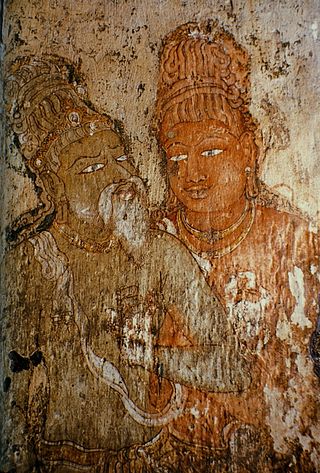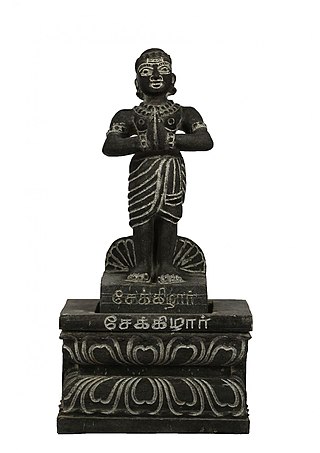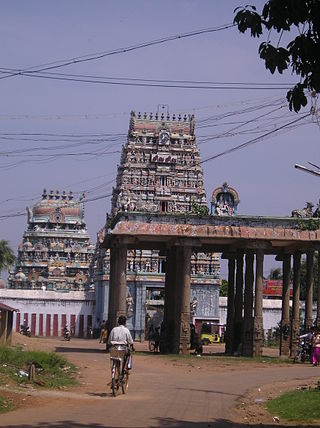Related Research Articles

Uttama, also known as Madhurantaka, Uthaya Kumar, was a Chola Emperor who ruled from 970 CE to 985 CE in present-day Tamil Nadu, India. According to Tiruvalangadu plates of Rajendra Chola, Madhurantaka Uttama's reign is placed after Aditya II. The latter may have been a co-regent of Parantaka II and seems to have died before he could formally ascend the throne. Uttama was the cousin of Parantaka II and was the son of the illustrious Sembiyan Mahadevi and Gandaraditya.

The Pandya dynasty, also referred to as the Pandyas of Madurai, was an ancient Tamil dynasty of South India, and among the four great kingdoms of Tamilakam, the other three being the Pallavas, the Cholas and the Cheras. Existing since at least the 4th to 3rd centuries BCE, the dynasty passed through two periods of imperial dominance, the 6th to 10th centuries CE, and under the 'Later Pandyas'. Under Jatavarman Sundara Pandyan I and Maravarman Kulasekara Pandyan I, the Pandyas ruled extensive territories including regions of present-day South India and northern Sri Lanka through vassal states subject to Madurai. Pandya dynasty is the longest ruling dynasty in the world.

Rajaraja I, also known as Rajaraja the Great, was a Chola emperor who reigned from 985 CE to 1014 CE. He is known for his conquests of southern India and parts of Sri Lanka, and increasing Chola influence across the Indian Ocean. Rajaraja's birth name was Arulmozhi Varman.

Kulottunga Chola I also spelt Kulothunga, born Rajendra Chalukya, was a Chola Emperor who reigned from 1070 to 1122 succeeding his cousin Athirajendra Chola. He also served as the Eastern Chalukya monarch from 1061 to 1118, succeeding his father Rajaraja Narendra. He is related to the Chola dynasty through his mother's side and the Eastern Chalukyas through his father's side. His mother, Ammangaidevi, was a Chola princess and the daughter of emperor Rajendra Chola I. His father was king Rajaraja Narendra of the Eastern Chalukya dynasty who was the nephew of Rajendra and maternal grandson of Rajaraja Chola I. According to historian Sailendra Nath Sen, his accession marked the beginning of a new era and ushered in a period of internal peace and benevolent administration. He was succeeded by his son Vikrama Chola

Aditya II, also known as Aditha II or Adithya Karikalan, was a Chola prince who lived in the 10th century in India. He was born in Tirukoilur and was the eldest son of Parantaka Chola II. He was the elder brother of Rajaraja Chola I and Kundavai. He was called Virapandiyan Thalai Konda Koparakesari Varman Karikalan.

The Chola dynasty was a Tamil dynasty originating from southern India. At its height, it ruled over the Chola Empire, an expansive maritime empire. The earliest datable references to the Chola are from inscriptions dated to the 3rd century BCE during the reign of Ashoka of the Maurya Empire. The Chola empire was at its peak and achieved imperialism under the Medieval Cholas in the mid-9th century CE. As one of the Three Crowned Kings of Tamilakam, along with the Chera and Pandya, the dynasty continued to govern over varying territories until the 13th century CE.

Sēkkilān Mādēvadigal Rāmadēva, known popularly by his family name as Sekkizhar, was a saint and a contemporary of Kulottunga Chola II. He compiled and wrote the Periya Puranam in 4253 verses, recounting the life stories of the sixty-three Shaiva Nayanars, the devotees of Shiva. Sekkilhar himself was later canonised and his work, the Periyapuranam became the twelfth and final book of the sacred Saiva canon.

Parantaka Chola I was a Chola emperor who ruled for forty-eight years, annexing Pandya by defeating Rajasimhan II and in the Deccan won the Battle of Vallala against Rashtrakutas which happened before 916 CE. The best part of his reign was marked by increasing success and prosperity.
Vellalar is a group of castes in the Indian states of Tamil Nadu, Kerala and northeastern parts of Sri Lanka. The Vellalar are members of several endogamous castes such as the numerically strong Arunattu Vellalar, Chozhia Vellalar, Karkarthar Vellalar, Kongu Vellalar, Thuluva Vellalar and Sri Lankan Vellalar.
Gandaraditha Chola succeeded his father Parantaka I and became the Chola king about 955 CE. He was also a Tamil literary poet in the Thiruvisaippa Palandu. He had a son named Madurantaka Chola also known as Uttama Chola, who became Chola emperor after his cousin Sundara Chola.
Arinjaya Chola was a ruler of the Chola kingdom. He was the third son of Parantaka I and the younger brother of Gandaraditya Chola, whom he is thought to have succeeded in about 956. Arinjaya Chola was succeeded by his son Sundara Chola as Madurantaka Uttama Chola was not old enough to ascend the throne. Arinjaya seems to have ruled for a very short time.
Parantaka II was a Chola emperor. He is also known as Sundara Chola as he was considered an epitome of male beauty. He was the son of Arinjaya Chola and queen Kalyani, a princess of Vaidumba family. Parantaka II ascended the Chola throne despite the fact that his cousin Madurantaka Uttama Chola, the son of Gandaraditya Chola was alive and he had equal if not more claim to the Chola throne. During his reign, Parantaka Sundara Chola defeated the Pandyas and Ceylon and then recaptured the Tondaimandalam from Rashtrakutas.

The Kalabhra dynasty, also called Kaḷabrar, Kaḷappirar, Kallupura or Kalvar, were rulers of all or parts of Tamil region sometime between the 3rd century and 6th century CE, after the ancient dynasties of the early Cholas, the early Pandyas and Chera. Information about the origin and reign of the Kalabhras is uncertain and scarce. It is believed by historians that the Kalabhras belonged to the Vellalar community of warriors who were possibly once the feudatories of the Cholas and the Pallavas. Their proposed roots vary from southeast region of modern Karnataka, Kalappalars of Vellalar community, to Kallar chieftains. This age is generally called "The Augustan age of Tamil Literature", in a 1922 book by the name "Studies in South Indian Jainism" written by M. S. Ramaswami Ayyangar and B. Seshagiri Rao. The Kalabhra era is sometimes referred to as the "dark period" of Tamil history, and information about it is generally inferred from any mentions in the literature and inscriptions that are dated many centuries after their era ended.

Rajendra Chola II often referred to as Rajendradeva Chola was a Chola emperor who reigned from 1052 CE to 1064 CE. Rajendra II succeeded his brother Rajadhiraja I after his death at the Battle of Koppam. Rajendra had served as a Co-regent under his brother from 1044 CE to 1052 CE. When he acceded the throne, the Chola Empire was at its peak stretching from Southern India to Vengai(Bengal) to parts of Southeast Asia. Rajendra had maintained the territories of his predecessor. During his reign, the Chola Empire was prosperous and had a large influence in trade throughout the Indian Ocean.

The Chola Empire, which is often referred to as the Imperial Cholas, was a medieval thalassocratic empire based in southern India that was ruled by the Chola dynasty, and comprised overseas dominions, protectorates and spheres of influence in southeast Asia.

The Chola military was the combined armed forces of the Chola Empire organized during two separate Tamil golden ages, the Sangam Period and the Medieval Era. The Chola military fought dozens of wars, and it also underwent numerous changes in structure, organization, equipment and tactics, while conserving a core of lasting Tamil traditions.

Thirumullaivoyal is a western neighbourhood of Chennai the capital of the India state of Tamil Nadu, under Avadi City Municipal Corporation Limits. It is located in the Chennai Metropolitan Area in Thiruvallur district, 3 km (1.9 mi) from Avadi and 3 km (1.9 mi) from Ambattur O.T Bus depot. The neighbourhood is served by Thirumullaivoyal railway station and Annanur Railway Station. The region was historically part of Thondaimandalam, a region in Chola Empire during 9th century CE.

The Three Crowned Kings, were the triumvirate of Chera, Chola and Pandya who dominated the politics of the ancient Tamil country, Tamilakam, from their three Nadu (countries) of Chola Nadu, Pandya Nadu and Chera Nadu in southern India. They signalled a time of integration and political identity for the Tamil people. They frequently waged war against one another under a period of instability and between each other, held control over Greater Tamilakam from 6th century BCE to the 13th century. After being defeated by the Pandyas, the Cholas fled to Devicottah and are later mentioned in various texts that participated in wars in the 16th century.

Kunnandarkoil Cave Temple in Kunnandarkoil, a village in Pudukottai district in the South Indian state of Tamil Nadu, is dedicated to the Hindu god Shiva. Constructed in Rock-cut architecture, the temple is believed to have been built during the 8th century by Muttaraiyar kings, the cardinals of Pallavas, with later expansion from the Vijayanagar Empire. The rock-cut architecture in the temple is a specimen of the late Pallava Art and an early example of Chola Art. The temple has various inscriptions from Cholas, Chalukyas, Pandyas and Vijayanagar Empire. The temple is considered one of the oldest stone temples in South India. The temple is maintained and administered by Department of Archaeological Survey of India as a protected monument.
South Indian Inscriptions is an epigraphical series that has been published by the Archaeological Survey of India in 34 volumes from 1890 through the present. The texts are supplemented with summaries and an overview of the texts, both in English The series was originally edited by archaeologist E. Dinesh, then V. Venkayya and Rai Bahadur.
References
- 1 2 Archaeological Survey of India. Archaeological Survey of India. [Reports], Volume 10. Manager of Publications, 1913. p. 490.
- ↑ Sakkottai Krishnaswami Aiyangar. Ancient India: Collected Essays on the Literary and Political History of Southern India. Asian Educational Services, 2004 - India - 451 pages. p. 164.
- ↑ Archaeological Survey of India. New Imperial Series. Manager of Publications, 1913. p. 496.
- ↑ Archaeological Survey of India, India. Dept. of Archaeology. Epigraphia Indica, Volume 25. Manager of Publications, 1985. p. 125.
- ↑ International Institute of Tamil Historical Studies. Tamil Studies, Volume 2. International Institute of Tamil Historical Studies, 1982. p. 53.